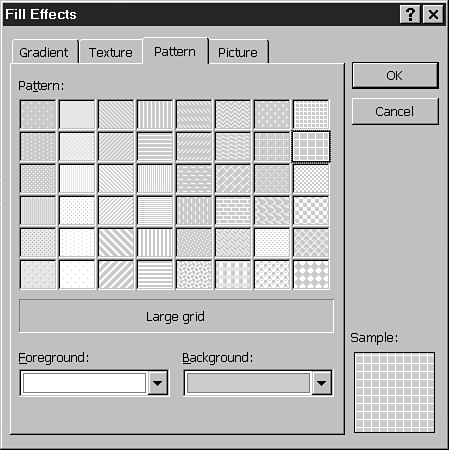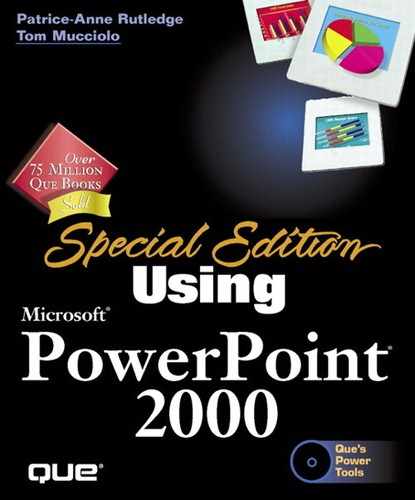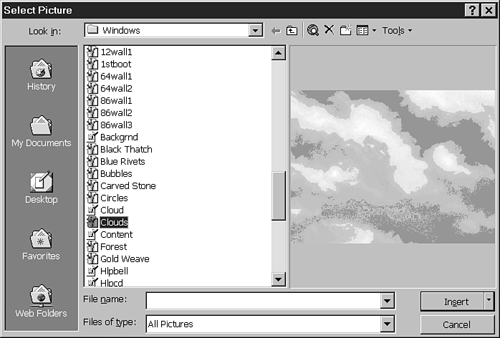Applying a Background
In addition to specific color backgrounds, you can also add special background effects such as shading, patterns, textures, and pictures. To apply a special background, choose Format, Background to open the Background dialog box, illustrated in Figure 6.15.
Figure 6.15. You can apply a special effects background to your presentation.

From the drop-down list in the Background Fill group box, choose one of the compatible colors under the Automatic color box.
Or click More Colors to open the Colors dialog box, in which you can select from many other colors or even specify your own custom color.
To apply a special background effect, choose Fill Effects from the drop-down list to open the Fill Effects dialog box, shown in Figure 6.16.
Figure 6.16. Choose from Gradient, Texture, Pattern, and Picture effects.

This dialog box includes four different tabs—Gradient, Texture, Pattern, and Picture—that guide you in selecting special effects backgrounds. After you select the fill effect you want, you can return to the Background dialog box where you can select Preview to see the effects before applying them, Apply to the current slide only, or Apply to All the slides in your presentation.
Applying a Gradient Background
To apply a gradient (p. 277) (shading) effect, follow these steps:
Choose Format, Background to open the Background dialog box.
From the drop-down list in the Background Fill group box, choose Fill Effects to open the Fill Effects dialog box.
Select the Gradient tab (see Figure 6.17).
Choose one of the following Colors options:
One color Applies a gradient effect with just one color. You choose the base color from the Color 1 drop-down list and specify how dark or light to make the contrast.
Figure 6.17. A gradient can add an interesting visual effect to your presentation.

Two colors Choose the two colors you want to use from the Color 1 and Color 2 drop-down lists.
Preset Displays a drop-down list of preset color combination options such as Daybreak, Peacock, or Rainbow.
Next, choose how to apply the gradient in the Shading Styles group box. Options include Horizontal, Vertical, Diagonal Up, Diagonal Down, From Corner, and From Title.
The Variants and Sample boxes preview your selections.
In the Background dialog box, you can select Preview to see the effects before applying them, Apply to the current slide only, or Apply to All the slides in your presentation.
Applying a Texture Background
Choose Format, Background to open the Background dialog box.
From the drop-down list in the Background Fill group box, choose Fill Effects to open the Fill Effects dialog box.
Select the Texture tab. Figure 6.18 shows this tab.
Figure 6.18. Textures can add variety to a presentation.

Scroll down the available textures until you find one you like. Select it and click OK to return to the Background dialog box.
In the Background dialog box, you can select Preview to see the effects before applying them, Apply to the current slide only, or Apply to All the slides in your presentation.
Click OK to close the dialog box.
If the existing textures don't suit your needs, you can use an external texture file such as a bitmap, Windows metafile, or other graphic image for which you installed an import filter. To choose an external texture graphic file that you have on your computer, click the Other Texture button on the Texture tab of the Fill Effects dialog box. The Select Texture dialog box, shown in Figure 6.19, opens.
Navigate to the image you want to use as a textured fill, select it, and click Insert. The fill is added to the Texture area of the dialog box, and you can use it as you would any of the existing fills.
Applying a Pattern Background
To apply a pattern (p. 278), follow these steps:
Choose Format, Background to open the Background dialog box.
From the drop-down list in the Background Fill group box, choose Fill Effects to open the Fill Effects dialog box.
Select the Pattern tab on the Fill Effects dialog box (see Figure 6.20).
Figure 6.19. Choose an external texture image from this dialog box.

Figure 6.20. PowerPoint offers many different pattern effects.

Choose Foreground and Background colors and then select from the many available patterns.
Note
The default foreground and background colors coordinate with your existing color scheme.
Click OK to return to the Background dialog box.
In the Background dialog box, you can select Preview to see the effects before applying them, Apply to the current slide only, or Apply to All the slides in your presentation.
Applying a Picture Background
To apply a picture to the background of your presentation, follow these steps:
Choose Format, Background to open the Background dialog box.
From the drop-down list in the Background Fill group box, choose Fill Effects to open the Fill Effects dialog box.
Select the Picture tab. (See Figure 6.21.)
Figure 6.21. Use your own image, such as a custom graphic or logo, as a background.

Click the Select Picture button to open the Select Picture dialog box, shown in Figure 6.22.
Select the folder that contains the picture you want from the Look in drop-down list.
Click OK to return to the Background dialog box.
In the Background dialog box, you can select Preview to see the effects before applying them, Apply to the current slide only, or Apply to All the slides in your presentation.
Caution
Although selecting a picture or graphic file of your own can definitely personalize and customize your presentation, be sure that it works as an effective background. Some images are simply too confusing or "busy" to use as a slide background.

